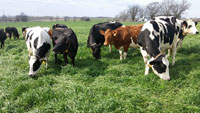
Dairy farmers may need a plan to offset production costs as demand for milk products drops due to COVID-19, say dairy specialist Stacey Hamilton and veterinarian Scott Poock of University of Missouri Extension.
Demand continues to plummet as key dairy customers such as schools and restaurants remain closed. In response, producers began dumping milk they could not sell through local and export markets.
The National Milk Producers Federation and International Dairy Foods Association are working with the USDA to tackle the crisis. Their proposed voluntary reduction plan asks producers to trim 10% of production from April through September from their March 2020 baseline. The proposal also includes provisions to fill U.S. food banks with dairy products and reopen the Dairy Margin Coverage plan.
The plan could affect all types of dairies—large, small, low-input or confinement, says Hamilton. “Producers should pencil out what management practices may benefit them if a voluntary reduction plan is put in place,” he says.
Hamilton and Poock recommend the following strategies for all dairies. Poock credits Chris Heins of Heins Family Farm for helping develop these strategies.
• Dry off cows early. “Balance diets so cows do not gain or lose weight, unless they need body condition,” says Poock. “If the cows are in good body condition, consider putting them on a field where rations and water sources are separated.” On their normal dry date, move them to the dry cow pen. This saves labor costs by milking fewer cows. It also means some loss of income.
• Cull low-production and problem cows. Sell cows with low reproduction rates, high somatic cell count, etc. Consider drying off mid-to-late-lactation DNBs (do not breeds) and put them on pasture or surplus feed if available. “This may add some value when markets return,” says Hamilton.
• Reduce feed costs and ask your nutritionist to adjust diets accordingly. “You don’t want to affect high producers as you will upset their peaks, but you might re-evaluate the medium-low diet,” Hamilton says. “When we get back to normal, you want high producers to have the ability to meet their potential.”
• Target milk solids versus volume. Within the Central Order, buyers pay producers based on components. “At all times we should think of energy corrected milk (ECM) rather than just volume,” says Hamilton. “It is possible to reduce volume and still gain fat and protein with an equivalent ECM. Producers will gain the proposed $3 per hundredweight bonus for reducing output by 10% while capturing extra income from fat and protein.”
• Feed milk to calves. If you do not have a pasteurizer, divert the milk to older calves. Discuss risks with your local veterinarian before feeding unpasteurized milk. Feeding milk to calves for a longer period before weaning moves milk away from the bulk tank, Hamilton says. “As we have learned more about ‘full potential’ feeding of calves, extending periods of milk/milk replacer and a more gradual transition off of milk has shown better results, especially in regard to rumen development. For dairies that do equal calving year-round, this may not reduce milk shipped much—about 1 pound milk per cow per day—while entirely seasonal herds could reduce shipped milk by about 4 pounds milk per cow per day.”
Other options:
• Consider feeding milk to all calves, heifers and bulls. This can reduce milk shipped and may add value to calves that are not needed as replacements later.
• Milk less often. Move all or part of confinement herds that are milking three times daily to two times. This would decrease production 10-15%. “If you do this for only part of the herd, we would suggest the mid to late lactation animals,” says Poock. This also could ease labor shortages. For pasture-based herds, consider moving to once-a-day milking.
• Consider total grass feeding. If pasture is available, pasture-based dairies may benefit from total grass feeding and elimination of supplement. If pasture is short, the producer should monitor body condition closely. Also, look at reducing the stocking rate by selling nonpregnant, older or low-producing cows.

For more than 100 years, University of Missouri Extension has extended university-based knowledge beyond the campus into all counties of the state. In doing so, extension has strengthened families, businesses and communities.


